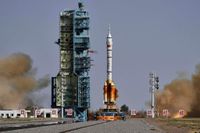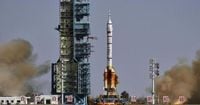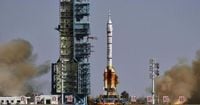Space has always captured the imagination—think of the moon landings, the silent ballet of satellites, and the ceaseless quest for cosmic discovery. But in the 21st century, the race for the stars has taken on a far grimmer tone. No longer just the realm of scientists and explorers, space has become a battleground, with nations scrambling for dominance in what may be the most consequential theater of modern warfare. A new arms race is unfolding high above our heads, and the stakes couldn’t be higher.
India, once seen as a newcomer to the cosmic club, has rapidly surged to the forefront of this new era. According to Communications Today, India has made remarkable advances in satellite technology for military reconnaissance, communication, and navigation. In 2019, the world watched as India’s Mission Shakti demonstrated the country’s anti-satellite (ASAT) missile capability, blasting a satellite in low-Earth orbit and signaling to the world that India was ready to defend its interests in space. The establishment of the Defence Space Agency further cemented India’s intent to weave space-based assets into its broader military operations. While India collaborates internationally on space security, it invests heavily in homegrown technologies to shield its satellites from hijacking, cyberattacks, and hostile actions.
Why all this urgency? Because space is now a central domain in modern warfare, with satellites acting as the nervous system for everything from global communications and media to military surveillance, missile detection, and intelligence gathering. The world’s major powers—namely the United States, Russia, China, and India—are racing not just to explore space, but to control it. And as recent events have shown, the consequences of losing that control can be immediate and deeply unsettling.
Consider the events of 2025, as reported by Military Times. During Russia’s Victory Day parade, hackers loyal to the Kremlin hijacked a satellite providing television service to Ukraine. Suddenly, Ukrainian viewers found themselves watching parade footage from Moscow, tanks and soldiers rolling by in a calculated display of intimidation. No shots were fired, but the psychological effect was unmistakable—a chilling demonstration of how orbital conflict can disrupt civilian life and undermine national morale.
Such attacks are hardly isolated incidents. As Russian forces invaded Ukraine in 2022, the US-based satellite company Viasat was targeted by a cyberattack that Kyiv blamed on Moscow. Malware infected tens of thousands of modems, creating outages across Europe and exposing just how vulnerable these orbital assets can be. As Tom Pace, CEO of cybersecurity firm NetRise, explained to Military Times, “If you can impede a satellite’s ability to communicate, you can cause a significant disruption. Think about GPS. Imagine if a population lost that and the confusion it would cause.”
And it’s not just about communications. With over 12,000 active satellites circling the planet, these devices underpin everything from navigation systems like GPS to intelligence gathering and early missile launch detection. Their loss could cripple military operations and wreak havoc on civilian infrastructure, plunging economies into chaos and leaving nations blind to looming threats.
The methods of attack are evolving at a dizzying pace. Direct-ascent anti-satellite missiles, lasers, and electronic jammers launched from Earth are just the beginning. There are now satellites capable of disabling or destroying others through collision, jamming, or even directed energy. The destruction of a single satellite can create clouds of debris, threatening thousands of other spacecraft and risking a catastrophic chain reaction known as the Kessler Syndrome—where space becomes so littered with hazardous fragments that it’s rendered unusable for everyone.
Cyber tactics and artificial intelligence are adding yet another layer of complexity. Automated AI-driven systems are increasingly necessary to detect threats, interpret data, and provide early warnings in real time. The US Space Force and China are both rapidly deploying such systems, making the orbital battlefield faster and more unpredictable than ever before.
But it’s not just the military satellites that are at risk. The rise of dual-use technologies—where commercial satellites can be repurposed for military aims—creates a "gray zone" of conflict, blurring the lines between civilian and military actions. This makes it harder to attribute attacks and, in turn, to deter them. As Communications Today points out, there is little international regulation or consensus on what constitutes acceptable behavior in space, raising the risk of escalation and destabilizing existing arms-control regimes.
The threats are not just theoretical. US officials have raised alarms about Russia’s development of a nuclear, space-based weapon designed to wipe out nearly every satellite in low-Earth orbit at once. This weapon, which would combine a physical attack with a nuclear burst to fry electronics, could render low-Earth orbit unusable for up to a year. Representative Mike Turner of Ohio compared the threat to Sputnik, calling it “the Cuban Missile Crisis in space.” He warned, “If this anti-satellite nuclear weapon would be put in space, it would be the end of the space age. It should never be permitted to go into outer space.”
Meanwhile, the competition is spreading beyond Earth’s orbit. Mining the moon and asteroids for valuable minerals, such as helium 3 (potentially useful for nuclear fusion), is driving a new frontier of rivalry. Acting NASA Administrator Sean Duffy recently announced plans to send a small nuclear reactor to the moon, emphasizing the need for the US to act before China or Russia. “We’re in a race to the moon, in a race with China to the moon,” Duffy said. “To have a base on the moon, we need energy and some of the key locations on the moon. ... We want to get there first and claim that for America.”
China and Russia have announced their own plans for lunar nuclear plants, and the US is eyeing missions to Mars. Artificial intelligence is expected to accelerate this competition, especially as the energy demands of AI itself grow. Joseph Rooke, a London-based cybersecurity expert, told Military Times, “This isn’t sci-fi. It’s quickly becoming a reality. If you dominate Earth’s energy needs, that’s game over.”
Despite these tensions, some voices urge restraint. Liu Pengyu, spokesperson for China’s Embassy in Washington, argued that it is the US, not China, that is militarizing space: “It has kept expanding military strength in space, created space military alliances, and attempted to turn space into a war zone. China urges the U.S. to stop spreading irresponsible rhetoric, stop expanding military build-up in space, and make due contribution to upholding the lasting peace and security in space.”
For now, nations are scrambling to create their own space programs, seeking commercial advantage and strategic independence. The US Space Force, established in 2019, is tasked with protecting American interests in space and defending satellites from attack. Their mission statement is clear: “Space is a warfighting domain, and it is the Space Force’s job to contest and control its environment to achieve national security objectives.”
As the world’s powers jostle for control of the final frontier, the need for new rules and arms-control agreements has never been more urgent. The consequences of a strategic conflict in orbit could be profound, with the potential to disrupt global economies, threaten civilian life, and even endanger humanity’s access to space itself. The race for orbital dominance is on, and the world is watching—nervous, hopeful, and all too aware of what’s at stake.


